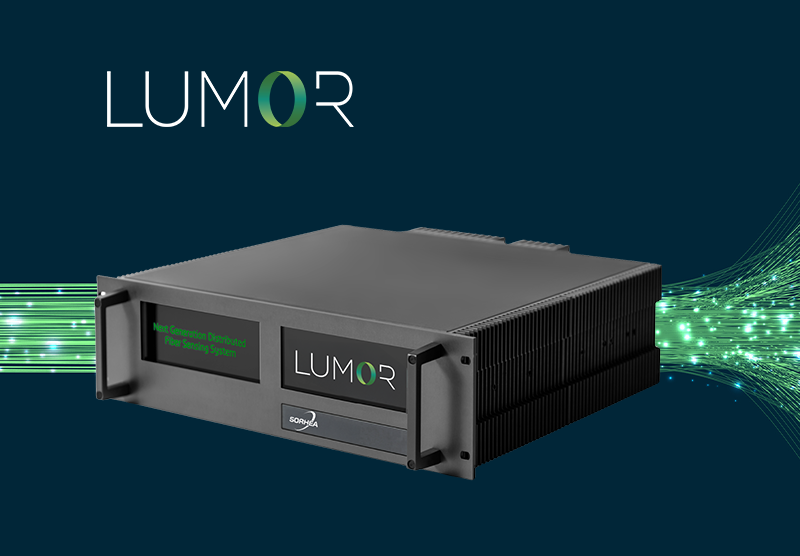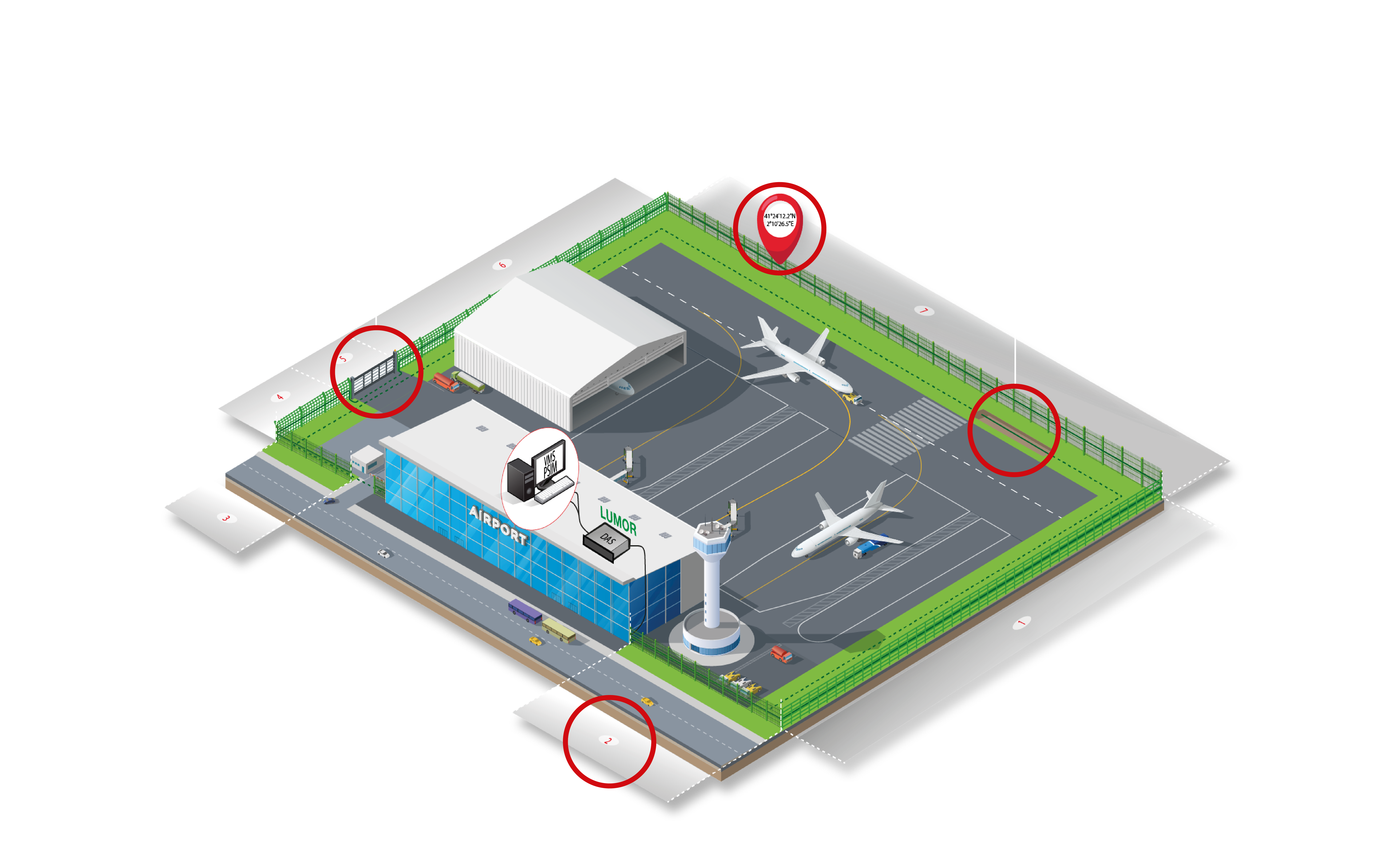New generation Fiber Optic detector
Quantitative DAS Technology for continuous and reliable surveillance
Versatile applications: fence-mounted or buried
Long-distance coverage: effective monitoring for large-scale infrastructures
Precise geolocation: Real-time intrusion detection with location accuracy every 6 meters
LUMOR fiber optic intrusion detection system is based on the latest-generation DAS (Distributed Acoustic Sensor) technology, enabling the protection of very long distances with a simple fiber optic cable. This system can be installed on fences or buried, providing discreet and continuous surveillance. It can cover up to 80 km with fiber installed on a fence, and up to 130 km when buried.
Thanks to this approach, LUMOR offers a highly sensitive and efficient surveillance solution, ideal for large-scale deployments, minimizing costs while enhancing the responsiveness of security personnel.
| DAS size | LUMOR S | LUMOR L |
| Range | S1 I SR | L1 I L2 |
| Number of fibers | S1: one I SR: two | L1: one I L2: two |
| Sensing range | Up to 20km (12.43 miles) fence and underground | Standard range up to 80km (49.71 miles) on fence and 130 km underground (800.78 miles) per fiber. Greater ranges possible using large gauge lengths |
| Detection redudancy | No I Yes | No I Yes |
| Hardware redudancy | Yes I No | Yes I Yes |
| Measurement type | Quantitative – Heterodyne optical phase measurement as a proxy for strain, vibration, and temperature | Quantitative – Heterodyne optical phase measurement as a proxy for strain, vibration, and temperature |
| Standard fiber types | Single Mode Fiber (SMF): ITU-T G.652, G.654 or G.65/ Multi-Mode Fiber (MMF): ITU-T G651.1 etc. (NB: range limited to 8km for MMF) | Single Mode Fiber (SMF): ITU-T G.652, G.654 or G.65 Multi-Mode Fiber (MMF): ITU-T G651.1 etc. (NB: Range limited to ~8 km for MMF) Engineered fiber: Continuous scatter enhanced type |
| Optical connections | LC/APC or SC/APC | E2000-PS APC |
| Size | Format: 19-inch 1U Enclosure / Height: 44.5 mm | 1.75 in / Width: 482.6mm | 19in / Depth: 293mm | 11.6 in | Format: 19-inch 3U Enclosure / Height: 132.5mm | 5.22in Width: 482.6 mm | 19 in / Depth: 471 mm | 18.5 in |
| Weight | 8 kg I 17.6 lbs | 16.5kg | 37lbs |
| Mounting | Slide rails for front and back support | Telescopic rackmount rails |
| Power supply | 24 / 48 VDC nominal (16.8 – 62.4 VDC) | Option 1: 110 / 230 VAC nominal (85 - 264 VAC) at 50 - 60Hz Dual redundant power supplies and cables Option 2: 24 / 48 VDC nominal (16.8 – 62.4 VDC) Dual redundant power supplies and cables |
| Power consumption | Max. 40W | 110 W |
| Operating temperature range | -5 ºC to 50 ºC | 23 ºF to +122 ºF | -5 ºC to 50 ºC | 23 ºF to +122 ºF |
| Operating humidity (max) | 85% non-condensing | 95% non-condensing |
| Ingress Protection | IP50 [Protected against dust] | IP50 [Protected against dust] |
| Electromagnetic compatibility Compliance (EMC) | USA: (FCC): 47 CFR Part 15 B / Canada: ICES-003 2012 EU:CE compliant - 2014/30/EU | USA (FCC): 47 CFR Part 15 B Canada: ICES-003 2020 2013/30/EU: EN- 55032:2015+A11:2020, EN55035:2017+A11:2020, EN301 489-1 V2.2.3, EN301 489-19 V2.1.1 UK: SI 2016/1091 and amendments |
| Zone management | Zone and schedule management of algorithms. | Zone and schedule management of algorithms. |
| Detection algorithms | Fiber break / Intrusion (walking, manual/mechanical digging, fence climbing/cutting, etc) / Leak detection Pig tracking / Real-time microseismic detection | Fiber break / Intrusion (walking, manual/mechanical digging, fence climbing/cutting, etc) / Leak detection Pig tracking / Real-time microseismic detection |
| Remote configuration | Web interface for full remote configuration and operation, including software and firmware updates, over the internet. | Web interface for full remote configuration and operation, including software and firmware updates, over the internet. |
| Interface support | MODBUS, OPC UA, Dry Contact, SMS via cloud, SMS via modem, Email interface. | MODBUS, OPC UA, Dry Contact, SMS via cloud, SMS via modem, Email interface. |
The DAS technology transforms a standard optical fiber into a virtual network of thousands of “microphones” spaced at regular intervals along the cable. These sensors detect variations in light retroreflected in the fiber, enabling precise real-time event detection, as well as geolocation and activity classification.
Compared to qualitative systems, the quantitative DAS technology offers greater dynamics, ensuring fine detection and optimized management of security interventions.



